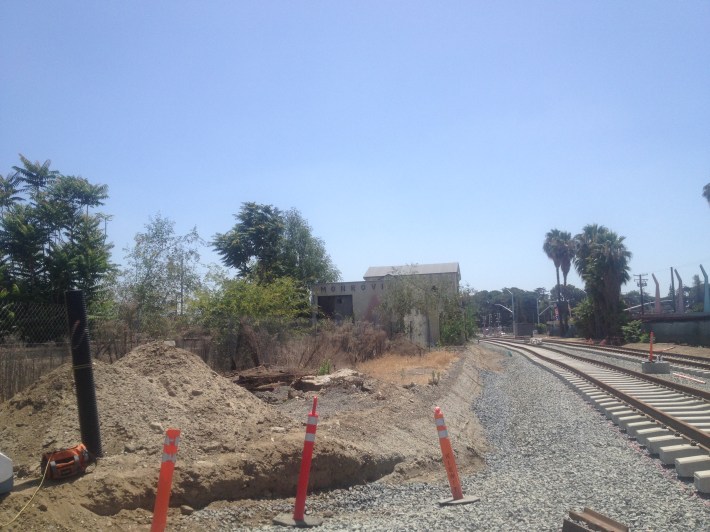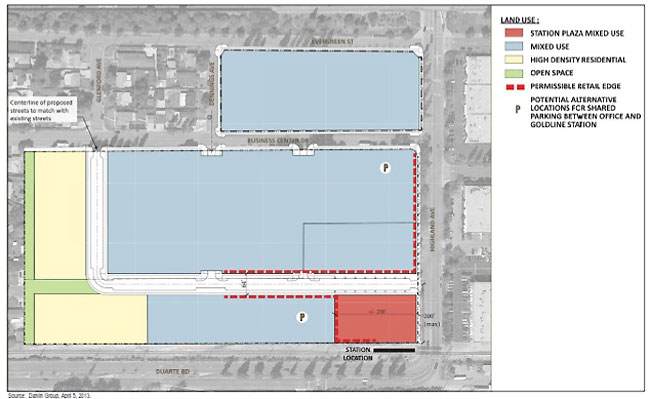In this fourth installment of the Foothill Gold Line Extension photo tour series, we explore planned Transit Oriented Developments (TOD) around some of the line's future stations.
Recently, Streetsblog’s Damien Newton and Aviv Kleinman joined a behind-the-scenes tour of the newest Gold Line Extension phase under construction in the San Gabriel Valley. We joined Albert Ho, head of Media Relations for the Metro Gold Line Foothill Extension Construction Authority, and Jeff Rowland, the Community Relations Manager for the Kiewit-Parsons Joint Venture, the contractors building the project. Part 1 of the series documented the rail corridor and stations. Part 2 highlighted the maintenance yard under construction in Monrovia. Part 3 looked at the new bridges.
For those just joining us, the Gold Line is a 19.7 mile light rail line running from East Los Angeles to Pasadena via Union Station in Downtown L.A. The line currently serves 21 stations, and is operated by Metro. The Gold Line Foothill Extension will extend from its current Sierra Madre Villa terminus east into the city of Azusa. The 11.3-mile new extension includes 6 new stations. The extension will serve five cities directly, and it is proposed to transform the San Gabriel Valley entirely. Once bounded by distress of being caught in freeway gridlock, San Gabriel Valley residents will now have the freedom to commute by rail into Downtown L.A. and endless locations from there by using the new Gold Line extension.
TODs are generally station-adjacent mixed-use areas. They often feature relatively dense housing so that residents can easily and safely walk to the nearby station. TODs frequently include apartment complexes, retail centers, and parks, which make for a rich mix of destinations around transit hubs. Find more about L.A. County Transit Oriented Development in this earlier SBLA series.
Monrovia Station Square is a great example of Transit Oriented Development.

The Monrovia Station Square is a large-scale improvement project underway, hosted by the City of Monrovia. The city plans to re-vamp the area immediately surrounding the Monrovia Gold Line station currently under construction. The Station Square intends to transform a largely-forgotten commercial/industrial neighborhood into a thriving and bustling town square. The development will adaptively re-use Monrovia's now-abandoned Santa Fe Railway station, transforming it into a new retail establishment. The city official we spoke with hopes it will become an artisan pizza shop. The current pothole-ridden park-and-ride lot will become a park, filled with green space, playgrounds, water features, and public art.




The intent is that Monrovia Station Square will become a hub for good vibes and happy people. Its location at the Gold Line Station will attract people from all along the Gold Line, as well as from connecting lines.
The city is working with local businesses and property owners to give incentives to transform the area surrounding the Square into an area rich with artisan shops, such as glassblowers and craft breweries. The city plans to install assorted public art pieces in the proposed park, and there is a proposed bus transit hub adjacent to the Gold Line station.
The station will feature a Metro parking structure, with additional car parking planned for the Monrovia Station Square development. There is a proposed 200-unit housing complex proposed in the immediate vicinity of the Station Square, perhaps soon to be joined by other housing complexes. Perhaps these will house people working in and commuting to Downtown L.A. or Pasadena, or students attending Azusa Pacific University, located just a few stations away.

Photo: City of Monrovia

A trolley shuttle is planned to connect Station Square with the historic downtown district located just a mile north by a trolley. This will echo the 1800s Myrtle Avenue Railroad, in which mule-drawn passenger railcars were towed up the Myrtle Avenue Hill, transporting passengers from the Santa Fe depot to Monrovia's downtown district. The mules were then allowed on a flatcar and gravity brought them and the railcar back to the rail depot at the bottom of the hill. After a quite foreseeable accident in which the railcar ran out of control, toppled over, and injured the poor mules, the animals refused to ride the train any more.

One Gold Line stop east of Monrovia, there is Duarte.

The city of Duarte also has a development plan for the area surrounding the future Duarte station.


Thank you for tuning into this four-part series on the Gold Line Extension!






